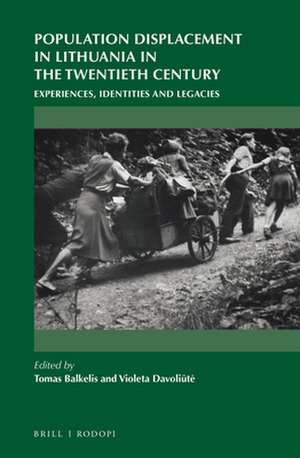Population Displacement in Lithuania in the Twentieth Century: Experiences, Identities and Legacies: On the Boundary of Two Worlds, cartea 43
Editat de Tomas Balkelis, Violeta Davoliūtėen Limba Engleză Hardback – 20 apr 2016
Contributors are: Tomas Balkelis, Daiva Dapkutė, Violeta Davoliūtė, Andrea Griffante, Ruth Leiserowitz, Klaus Richter, Vasilijus Safronovas, Vitalija Stravinskienė, Arūnas Streikus and Theodore R. Weeks.
Preț: 557.37 lei
Preț vechi: 679.72 lei
-18% Nou
Puncte Express: 836
Preț estimativ în valută:
106.68€ • 110.95$ • 89.40£
106.68€ • 110.95$ • 89.40£
Carte indisponibilă temporar
Doresc să fiu notificat când acest titlu va fi disponibil:
Se trimite...
Preluare comenzi: 021 569.72.76
Specificații
ISBN-13: 9789004314092
ISBN-10: 9004314091
Pagini: 264
Dimensiuni: 155 x 235 mm
Greutate: 0.54 kg
Editura: Brill
Colecția Brill
Seria On the Boundary of Two Worlds
ISBN-10: 9004314091
Pagini: 264
Dimensiuni: 155 x 235 mm
Greutate: 0.54 kg
Editura: Brill
Colecția Brill
Seria On the Boundary of Two Worlds
Cuprins
PREFACE
INTRODUCTION
Acknowledgement
List of contributors
I. POPULATION DISPLACEMENT DURING WORLD WAR ONE AND ITS AFTERMATH
CHAPTER 1
Andrea Griffante. Making the Nation: Refugees, Indigent People, and Lithuanian Relief, 1914-1920
CHAPTER 2
Tomas Balkelis. Forging a “Moral Community”: the Great War and Lithuanian Refugees in Russia
CHAPTER 3
Klaus Richter. Displacement without Moving: Secession, Border Changes and Practices of Population Politics in Lithuania (1916 – 1923)
II. POPULATION DISPLACEMENT IN THE KLAIPĖDA REGION
CHAPTER 4
Vasilijus Safronovas. Population of the Klaipėda Region and the Balance of Power in the Eastern Baltic Region, 1919-1960
CHAPTER 5
Ruth Leiserowitz. Population Shifts and Displacement in the Memel Region
III. POPULATION DISPLACEMENT DURING WORLD WAR TWO AND ITS AFTERMATH
CHAPTER 6
Theodore R. Weeks. Repopulating Vilnius, 1939-1949
CHAPTER 7
Vitalija Stravinskienė. Between Poland and Lithuania: Repatriation of Poles from Lithuania, 1944-1947
CHAPTER 8
Violeta Davoliūtė. A “Forgotten” History of Soviet Deportation: The Case of Lithuanian Jews
CHAPTER 9
Arūnas Streikus. Religious Life in a Displaced Society: the Case of Post-War Lithuania, 1945-1960
CHAPTER 10
Daiva Dapkutė. Lithuanian Diaspora: from Displaced Persons to Diaspora Politics
INTRODUCTION
Acknowledgement
List of contributors
I. POPULATION DISPLACEMENT DURING WORLD WAR ONE AND ITS AFTERMATH
CHAPTER 1
Andrea Griffante. Making the Nation: Refugees, Indigent People, and Lithuanian Relief, 1914-1920
CHAPTER 2
Tomas Balkelis. Forging a “Moral Community”: the Great War and Lithuanian Refugees in Russia
CHAPTER 3
Klaus Richter. Displacement without Moving: Secession, Border Changes and Practices of Population Politics in Lithuania (1916 – 1923)
II. POPULATION DISPLACEMENT IN THE KLAIPĖDA REGION
CHAPTER 4
Vasilijus Safronovas. Population of the Klaipėda Region and the Balance of Power in the Eastern Baltic Region, 1919-1960
CHAPTER 5
Ruth Leiserowitz. Population Shifts and Displacement in the Memel Region
III. POPULATION DISPLACEMENT DURING WORLD WAR TWO AND ITS AFTERMATH
CHAPTER 6
Theodore R. Weeks. Repopulating Vilnius, 1939-1949
CHAPTER 7
Vitalija Stravinskienė. Between Poland and Lithuania: Repatriation of Poles from Lithuania, 1944-1947
CHAPTER 8
Violeta Davoliūtė. A “Forgotten” History of Soviet Deportation: The Case of Lithuanian Jews
CHAPTER 9
Arūnas Streikus. Religious Life in a Displaced Society: the Case of Post-War Lithuania, 1945-1960
CHAPTER 10
Daiva Dapkutė. Lithuanian Diaspora: from Displaced Persons to Diaspora Politics
Notă biografică
Dr. Tomas Balkelis is a visiting scholar at the Centre for Russian, East European and Eurasian Studies at Stanford University and a senior researcher at the Lithuanian Institute of History in Vilnius. He is the author of The Making of Modern Lithuania (Routledge, 2009). His research fields include nationalism, population displacement and paramilitary violence in the Baltic States.
Dr. Violeta Davoliūtė is a visiting researcher at MacMillan Centre for International and Area Studies, Yale University and a senior researcher at the Lithuanian Culture Research Institute in Vilnius. She is the author of The Making and Breaking of Soviet Lithuania: Memory and Modernity in the Wake of War (Routledge, 2013). Her research is focused on the history of the Lithuanian elites under Nazi and Soviet rule, questions of trauma and memory, and the social and cultural effects of forced modernization, sovietization and mass displacement in the Baltic States.
Dr. Violeta Davoliūtė is a visiting researcher at MacMillan Centre for International and Area Studies, Yale University and a senior researcher at the Lithuanian Culture Research Institute in Vilnius. She is the author of The Making and Breaking of Soviet Lithuania: Memory and Modernity in the Wake of War (Routledge, 2013). Her research is focused on the history of the Lithuanian elites under Nazi and Soviet rule, questions of trauma and memory, and the social and cultural effects of forced modernization, sovietization and mass displacement in the Baltic States.
Recenzii
“The authors, perhaps inadvertently, acknowledge a debt to Jan Gross in also suggesting that the impact of the Second World War needs to be understood in relation to the First World War. Gross suggested in passing that Jews who fled eastwards in 1939-41 during the Soviet occupation of Belarus and western Ukraine did so less in anticipation of a Nazi onslaught than because of memories of pogroms during the First World War and its immediate aftermath. Whatever the validity of this suggestion, it is imperative to think about the associations between the two world wars, and one of the most fruitful aspects of this book is that its contributors are attuned to this kind of broad chronological perspective. Mid-century upheavals can no longer be detached from earlier developments.”
Peter Gatrell, University of Manchester
Peter Gatrell, University of Manchester





